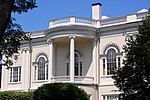James Putnam Jr. House

The James Putnam Jr. House is a historic First Period house in Danvers, Massachusetts. It is a 2+1⁄2-story wood-frame structure, five bays wide, with a gambrel roof pierced by three interior chimneys. The house was built in stages, beginning in about 1715 as a typical First Period double pile house, with a center entrance, chimney and winder staircase (two stories, two rooms wide and one deep). To this another double pile structure was added to the front in the mid 1700’s creating an early Federal style central hall structure. This expansion was completed by the last Attorney General to King George III, who fled to Nova Scotia at the beginning of the Revolution. The house's most prominent Colonial resident was Colonel Timothy Pickering, who leased it from 1802 to 1804, when he was serving as United States Senator.The house was added to the National Register of Historic Places in 1990.
Excerpt from the Wikipedia article James Putnam Jr. House (License: CC BY-SA 3.0, Authors, Images).James Putnam Jr. House
College Pond Drive, Danvers
Geographical coordinates (GPS) Address Nearby Places Show on map
Geographical coordinates (GPS)
| Latitude | Longitude |
|---|---|
| N 42.575833333333 ° | E -70.949444444444 ° |
Address
College Pond Drive 5
01923 Danvers
Massachusetts, United States
Open on Google Maps











